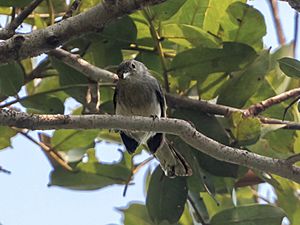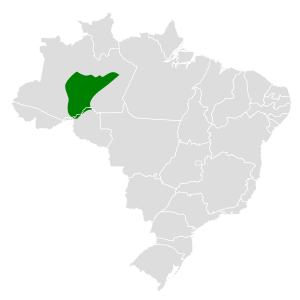Inambari gnatcatcher facts for kids
Quick facts for kids Inambari gnatcatcher |
|
|---|---|
 |
|
| Scientific classification | |
 |
The Inambari gnatcatcher (Polioptila attenboroughi) is a tiny bird that lives only in Brazil. It is part of the gnatcatcher family, known for their small size and quick movements. This special bird was only officially discovered and named recently, in 2013.
Contents
Discovering the Inambari Gnatcatcher
Scientists officially described the Inambari gnatcatcher as a new species in 2013. Before this, some thought it was just a type of Guianan gnatcatcher. But after studying it closely, many bird experts agreed it was a unique species.
This bird is considered monotypic. This means it is the only member of its species. It does not have any subspecies or different types within its group.
What the Inambari Gnatcatcher Looks Like
The first Inambari gnatcatcher studied was an adult male. It weighed about 6 grams (0.2 ounces), which is very light! Its head, the back of its neck, and its neck are a plain gray color.
Its throat, chest, and upper belly are also gray, but they are lighter near its beak. The lower part of its belly is white. This bird also has a white ring around its eye, but it's not a full circle. The feathers closest to its body on its tail are black. The outer tail feathers are mostly white, and the ones in between mix black and white.
Where the Inambari Gnatcatcher Lives
Scientists do not yet know the full area where the Inambari gnatcatcher lives. All the times it has been seen are in the central Amazon Basin of Brazil. This area is south of the Rio Solimões (which is the upper part of the Amazon River) and west of the Rio Madeira.
This region is known as the Inambari area. The Inambari gnatcatcher lives in the tops of tall, moist forests. These forests grow on sandy soil and are usually found below 500 meters (1,640 feet) in elevation.
Inambari Gnatcatcher Behavior
How It Finds Food
Scientists are still learning about what the Inambari gnatcatcher eats. Like other gnatcatchers, it likely eats small insects and other tiny creatures. It usually looks for food alone or with a partner.
It often joins groups of different bird species that are foraging together. This bird mostly picks insects off leaves. It also flies out quickly to catch insects in the air.
Reproduction and Nests
Right now, scientists know nothing about the Inambari gnatcatcher's nests or eggs. Its breeding habits are a complete mystery.
Its Song
The Inambari gnatcatcher has a loud song. It sounds like a series of six notes that are all at a similar pitch. You can listen to its song here: [1]. It also has another, more complex song.
Protecting the Inambari Gnatcatcher
The Inambari gnatcatcher is a new species, so its conservation status is still being studied. However, its home is facing some challenges. New farms for soybeans and roads are being built in Brazil. One road, the BR-319 highway, goes right through the area where this bird lives. This development is a clear threat to the Inambari gnatcatcher's habitat.
See also
 In Spanish: Perlita de Inambari para niños
In Spanish: Perlita de Inambari para niños
- List of things named after David Attenborough and his works

